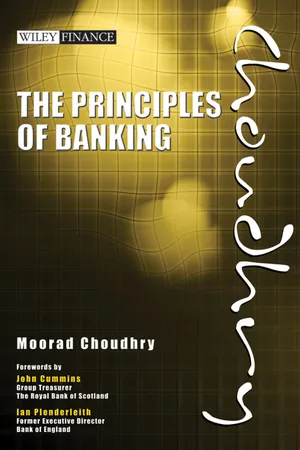
- English
- ePUB (mobile friendly)
- Available on iOS & Android
The Principles of Banking
About this book
The ultimate guide for bank management: how to survive and thrive throughout the business cycle
An essential guide for bankers and students of finance everywhere, The Principles of Banking reiterates that the primary requirement of banking—sound capital and liquidity risk management—had been forgotten in the years prior to the financial crash. Serving as a policy guide for market practitioners and regulators at all levels, the book explains the keys to success that bankers need to follow during good times in order to be prepared for the bad, providing in-depth guidance and technical analysis of exactly what constitutes good banking practice.
Accessible to professionals and students alike, The Principles of Banking covers issues of practical importance to bank practitioners, including asset-liability management, liquidity risk, internal transfer pricing, capital management, stress testing, and more. With an emphasis on viewing business cycles as patterns of stable and stressful market behavior, and rich with worked examples illustrating the key principles of bank asset-liability management, the book is an essential policy guide for today and tomorrow. It also offers readers access to an accompanying website holding policy templates and teaching aids.
- Illustrates how unsound banking practices that were evident in previous bank crashes were repeated during the creation of the 2007-2008 financial market crisis
- Provides a template that can be used to create a sound liquidity and asset-liability management framework at any bank
- An essential resource for the international banking community as it seeks to re-establish its credibility, as well as for students of finance
- Explains the original principles of banking, including sound lending policy and liquidity management, and why these need to be restated in order to avoid another bank crisis at the time of the next economic recession
- Covers topics of particular importance to students and academia, many of which are marginally—if ever—addressed in current text books on finance
- Offers readers access to a companion website featuring invaluable learning and teaching aids
Written by a banking practitioner with extensive professional and teaching experience in the field, The Principles of Banking explains exactly how to get back to basics in risk management in the banking community, essential if we are to maintain a sustainable banking industry.
"engaging and interesting and, more importantly, easily understood, allowing a clear picture to emerge of how the principle or concept under discussion is to be applied in the real world."
- GraemeWolvaardt, Head of Market & Liquidity Risk Control, Europe Arab Bank Plc
Frequently asked questions
- Essential is ideal for learners and professionals who enjoy exploring a wide range of subjects. Access the Essential Library with 800,000+ trusted titles and best-sellers across business, personal growth, and the humanities. Includes unlimited reading time and Standard Read Aloud voice.
- Complete: Perfect for advanced learners and researchers needing full, unrestricted access. Unlock 1.4M+ books across hundreds of subjects, including academic and specialized titles. The Complete Plan also includes advanced features like Premium Read Aloud and Research Assistant.
Please note we cannot support devices running on iOS 13 and Android 7 or earlier. Learn more about using the app.
Information
An Introduction to Banking
| Service or function | Revenue generated | Risk |
| Lending | ||
| – Retail | Interest income, fees | Credit, Market |
| – Commercial | Interest income, fees | Credit, Market |
| – Mortgage | Interest income, fees | Credit, Market |
| – Syndicated | Trading, interest income, fees | Credit, Market |
| Credit cards | Interest income, fees | Credit, Operational |
| Project finance | Interest income, fees | Credit |
| Trade finance | Interest income, fees | Credit, Operational |
| Cash management | ||
| – Processing | Fees | Operational |
| – Payments | Fees | Credit, Operational |
| Custodian | Fees | Credit, Operational |
| Private banking | Commission income, interest income, fees | Operational |
| Asset management | Fees, performance payments | Credit, Market, Operational |
| Capital markets | ||
| – Investment banking | Fees | Credit, Market |
| – Corporate finance | Fees | Credit, Market |
| – Equities | Trading income, fees | Credit, Market |
| – Bonds | Trading income, interest income, fees | Credit, Market |
| – Foreign exchange | Trading income, fees | Credit, Market |
| – Derivatives | Trading income, fees | Credit, Market |
| Core operating income | % share |
| Net interest income | 62 |
| Fees and commissions | 27 |
| Trading income | 11 |
Interest Income
Fees and Commissions
Table of contents
- Cover
- Series Page
- Series1 Page
- Title Page
- Copyright
- Dedication
- Forewords
- Preface
- Acknowledgements
- About the Author
- Part I: A Primer on Banking
- Part II: Bank Asset and Liability Management
- Part III: Bank Liquidity Risk Management
- Part IV: Bank Strategy and Governance
- Part V: Applications Software, Policy Templates and Teaching Aids
- Afterword
- List of Terms and Their Abbreviations
- Index